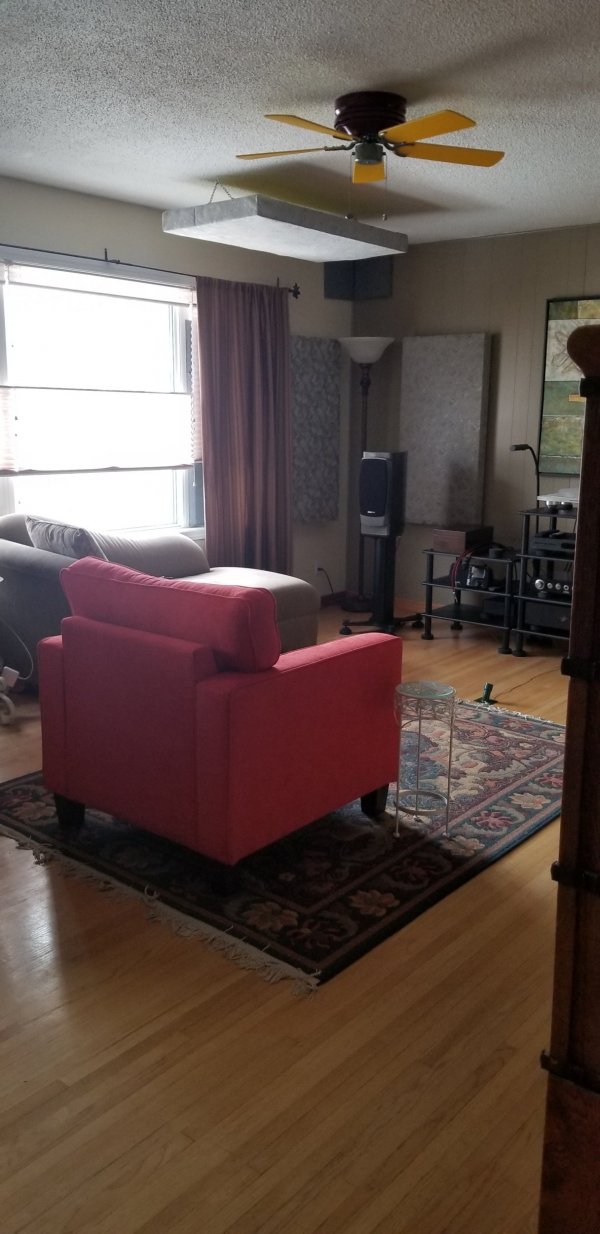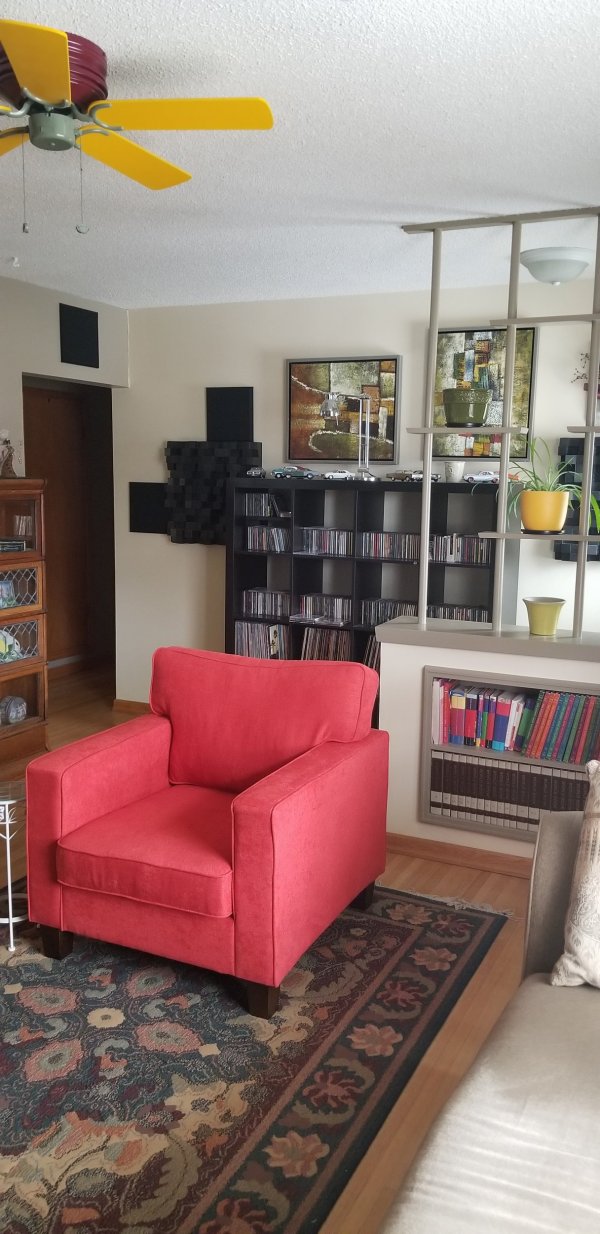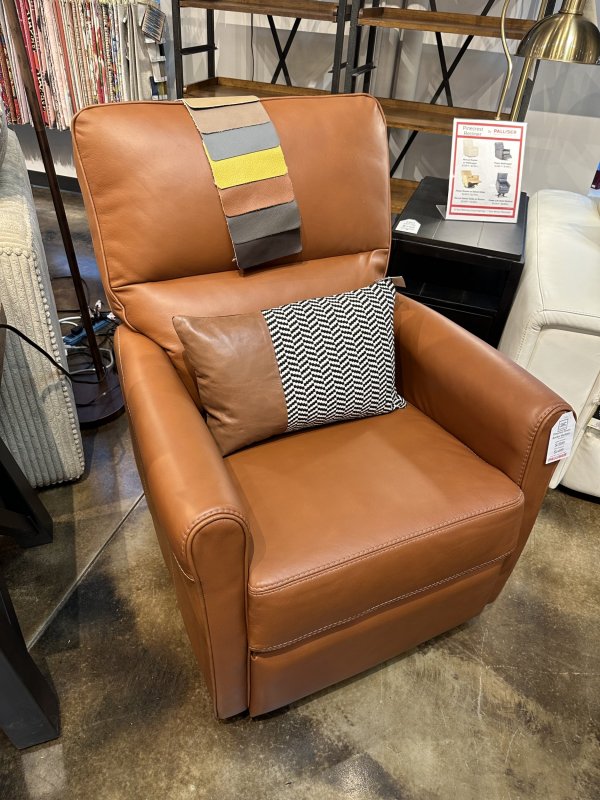StreamF, is this lower back chair you're measuring well with, a current production model?I agree. I had a very comfortable armchair with a high back. Not good in terms of sound.

And I was able to prove that with measurements. A good measured value is the IACC (Interaural Coherence Coefficient). The IACC values allow conclusions to be drawn about the quality of the stereo image.
In the meantime I changed the listening room and the old chair moved with me. With the high backrest I lost about 10% IACC10 (incoming sound in the first 10ms). The new chair brought more seating comfort despite the lack of a headrest.

With the new chair, the IACC10 achieved a fantastic 95%.

Looking For The Perfect Listening Chair
- Thread starter Steve williams
- Start date
You are using an out of date browser. It may not display this or other websites correctly.
You should upgrade or use an alternative browser.
You should upgrade or use an alternative browser.
Looks comfortable and it’s not to high which is good.I had a Stressless, but I would fall a sleep...not a good thing if you're listening to LPs.
Got this from Pier 1 before they closed their store.
View attachment 86656
Since this is a thread about the Perfect Listening Chair, I'll be brief.I don't really understand how it derives that information from a measurement like that
Interaural Cross Correlation (IACC) is the measure of the difference in signals received by two ears of a person. It depends on the coherence of the incoming sound. In our case from two speakers. The higher the value, the better the soundstage can be perceived.
There are different methods. I prefer the simple method of an one-point measurement at the sweet spot.does it do 2 sweeps
I use Acourate for room correction (room modes) and for speaker correction (timing).do you use it for that or just room correction?
The microphone must be meticulously centered at ear level. That doesn't work if your own head is bothering you.I think there should be a body in the chair when you measure
Yes: https://www.leolux.com/collection/armchairs/scylla-enStreamF, is this lower back chair you're measuring well with, a current production model?
Since this is a thread about the Perfect Listening Chair, I'll be brief.
Interaural Cross Correlation (IACC) is the measure of the difference in signals received by two ears of a person. It depends on the coherence of the incoming sound. In our case from two speakers. The higher the value, the better the soundstage can be perceived.
There are different methods. I prefer the simple method of an one-point measurement at the sweet spot.
I use Acourate for room correction (room modes) and for speaker correction (timing).
The microphone must be meticulously centered at ear level. That doesn't work if your own head is bothering you.Our hearing is very good at blocking out our own body, so you don't have to sit in it to measure.
Thanks Stream
I will look into it a bit more but it did seem to me to be about early reflection vs direct sound as much as each ear recieving precisely equal info which is more a matter of symmetry ( and quite important)
The reflections are at the heart of the notion that high backed chairs are inherently bad .. when I have a moment I will do a diagram to explain my thinking
Cheers
Phil
early reflection vs direct sound
Yes, it's about the direct sound that we need for localization. The first 10ms to 15ms are decisive. If the direct sound is superimposed by diffuse sound (the high backrest), the coherence is inevitably reduced (IACC10).
Therefore it is generally better to keep the listening area behind your head free. Loudspeakers positioned too close to side walls have the same negative effect. But I'm not an acoustics expert and I might explain it wrong.
Cheers
Gabriel
In terms of acoustic science/physics employed, it is not merely (only) the direct speaker sound waves moving toward the listener from the front or front-sides. Rather, rear-room reflected sound sources are of high relative importance as well. This is most beneficial when the rear wall and rear side walls are properly treated with absorption and diffusion. It is quite discernable and quite measurable. It is not about the room being "quiet" per se, but comprises a number of actual acoustic properties, as well as significant psychoacoustic principles.The interesting thing about a high back chair is that most would be soft and rounded so primarily reflect high frequency which would be mainly reflected away from your ear due to curve ... or ar least be very low in level so I dont believe it makes a big difference
If you had a stupendesly quiet room and very well controlled acoustics I could imagine it may be discernable with some listening effort but generally I would expect not
On the other hand if your seat is close to a back wall I think they offer a good shield from rear reflections and can be of benifit
Plus I am slob and like to reeeelax!
Phil
One needs to consider rear-room reflected sound, typically diffused.Thanks Stream
I will look into it a bit more but it did seem to me to be about early reflection vs direct sound as much as each ear recieving precisely equal info which is more a matter of symmetry ( and quite important)
The reflections are at the heart of the notion that high backed chairs are inherently bad .. when I have a moment I will do a diagram to explain my thinking
Cheers
Phil
Thanks GabrielYes, it's about the direct sound that we need for localization. The first 10ms to 15ms are decisive. If the direct sound is superimposed by diffuse sound (the high backrest), the coherence is inevitably reduced (IACC10).
Therefore it is generally better to keep the listening area behind your head free. Loudspeakers positioned too close to side walls have the same negative effect. But I'm not an acoustics expert and I might explain it wrong.
Cheers
Gabriel
I know enough about acoustics to be confused most of the time
I am a big fan of the 10ms ( or longer if possible) gap between direct and indirect so agree with you
What I am suggesting that the chair with a body in it has less effect than the microphone measurement suggests
The diagram has a head and a narrow head rest behind with speakers 3m away and 3m apart. shows how the head will prevent reflections occurring that the microphone will "hear with no head in place.
Similarly floor reflections hit the back of the
chair reflecting back to the mike without a body to reflect them back into the room.
I feel I need to defend the much maligned high back !
I must say my experience is if you have plenty of space at the sides you will get a more precise soundstage than if you are tight for space behind your seat and high back seats dont seem to have that much of an impact... In any case it is a way smaller area to deal with.
Cheers
Phil
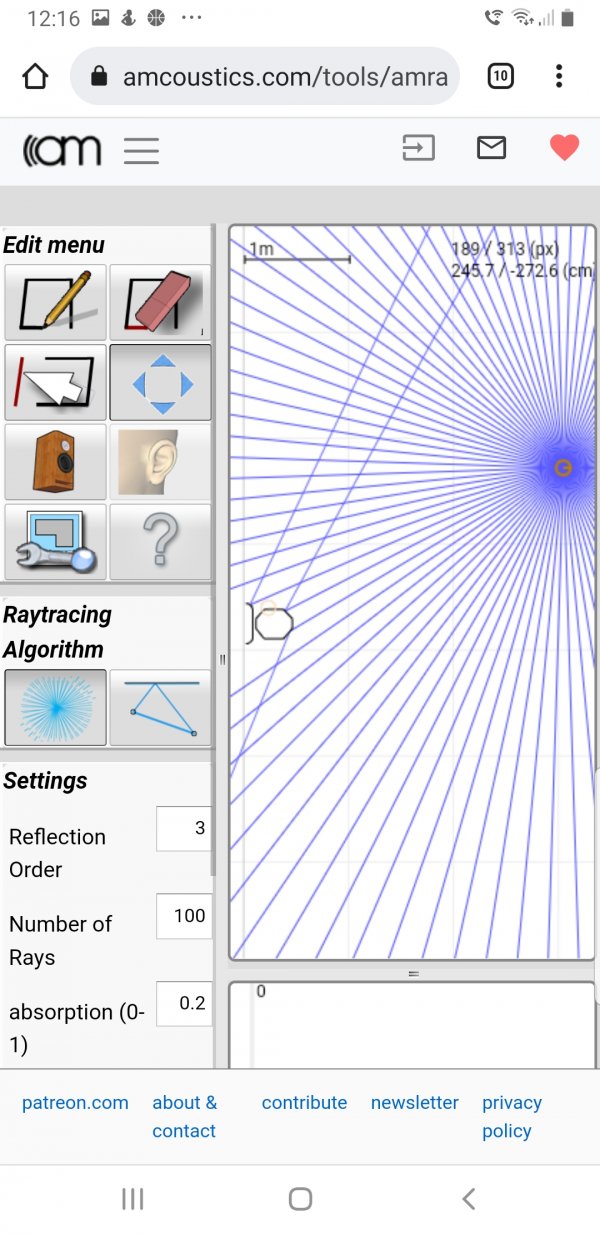
UnderstoodOne needs to consider rear-room reflected sound, typically diffused.
Trying to stay out of room acoustics and focus on the chair
10ms is a LONG time in audio terms. Why would you want that, unless it is strictly for effect?
(My apologies for the off topic post)
Tom
(My apologies for the off topic post)
Tom
Tom10ms is a LONG time in audio terms. Why would you want that, unless it is strictly for effect?
(My apologies for the off topic post)
Tom
Reflections that arrive within 10ms or thereabouts ( roughly equivalent to 3m travel ) of direct sound "smear" the direct sound and mask the finer detail .... best to drop it in level via absorbers or diffusers or redirect it away from listening spot ( best in my view )
When you employ this strategy it just sounds clearer and more relaxing ... your brain doesnt have to work as hard
I dont think any acoustic engineers would argue about this
Cheers
Phil
Super late reply, but a few years go we bought a love seat from "The Article" along with matching pillows, it's held up well for the price, no joint in the middle and a low back. The white boucle fabric is beautiful, at the time it came in houndstooth as well, but I see there is a gray color now. It took a month or two to come from China as I recall.Understood, but does such an audiophile approved seating option exist?
Gabriola
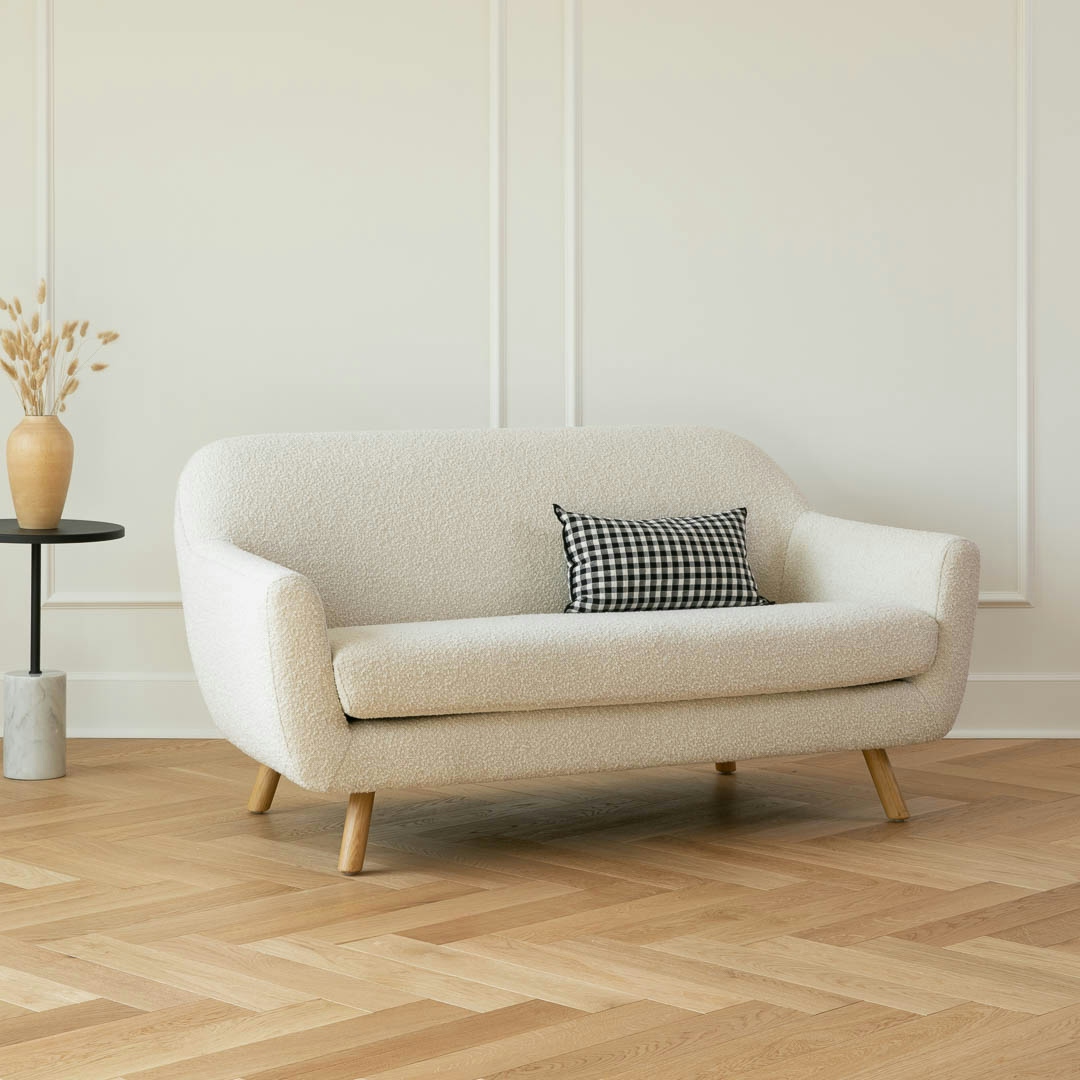
Gabriola 64" Loveseat - Ivory Bouclé
A loveseat that screams “easy street” in every sense. Is it the bouclé fabric? The curvaceous proportions held up by a solid wood frame? How it will seamlessly suit the rest of your decor, regardless of your style? It’s all this and more. Take a saunter down easy street, end up on the Gabriola.
If you really want houndstooth, I found one but it's a lot more money (see below).
Mid-Century Modern Furniture: Discover and Shop Our Finest Selections
Modern furniture with clean lines & sculptural forms. Affordable luxury furniture. Handmade & customizable. Versatile pieces. Create a contemporary oasis now!
I cannot see the difference in the two besides the price.
Last edited:
The loveseat is in my living room (small), it's never been in the listening room in the walk-out basement below.Wow, that’s a sweet looking loveseat! It looks like it might sit a little low, though, for audio listening. What’s your experience on this?
However you just gave me an idea should my listening room become more of a home theater one day.
It does NOT sit super low, it is sized perfectly for my 5'-1" height wife and my 5'-5" height self (short legs not floundering like a child as on higher seats).
This loveseat is higher than anything at Ikea, dang those things are low.
Last edited:
what brand and model pleaseI searched for a long time till I found this chair. Bold firm, leaves my ears at tweeter height. very comfortable.
Similar threads
- Replies
- 4
- Views
- 2K
- Replies
- 108
- Views
- 56K
- Replies
- 0
- Views
- 3K
| Steve Williams Site Founder | Site Owner | Administrator | Ron Resnick Site Owner | Administrator | Julian (The Fixer) Website Build | Marketing Managersing |







